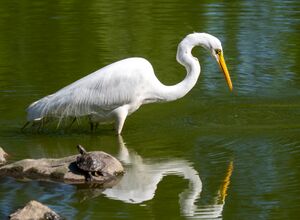الطيور الخواضة
| Waders (American) | |
|---|---|

| |
| Great egret (Ardea alba) | |
| Scientific classification | |
| أصنوفة غير معروفة (أصلحها): | الحياة |
| مملكة: | الحيوانية |
| Phylum: | حبليات |
| Class: | طيور |
| دون الفصل: | حديثات الفك |
| فوق الرتبة: | الطيور_الجديدة |
| Groups included | |
Birders in Canada and the United States refer to several families of long-legged wading birds in semi-aquatic ecosystems as waders. These include the families Phoenicopteridae (flamingos), Ciconiidae (storks), Threskiornithidae (ibises and spoonbills), Ardeidae (herons, egrets, and bitterns), and the extralimital families Scopidae (hamerkop) and Balaenicipitidae (shoebill) of Africa.[1] Elsewhere in the world, the word refers to what North Americans call a "shorebird", various families of the order Charadriiformes.[1][2] In the past all of these families were classified in the order Ciconiiformes based on overall similarity in anatomy and ecology, as well as some molecular data.[3][4] However recent genomic studies have found that this group to be polyphyletic, with flamingos being more closely related to grebes while ibises, herons, the hamerkop and the shoebill are more closely related to pelicans.[5][6] As a result of these changes flamingos are placed in their own order Phoenicopteriformes and Ciconiiformes are solely restricted to the storks. The rest of the waders have been reclassified into the order Pelecaniformes.[7]
In some field guides, the families Gruidae (cranes) and Aramidae (limpkin) are also considered to be waders too. However unlike the previously mentioned families, cranes and the limpkin were never thought to be closely related to the heron-like birds and have always been classified as members of the order Gruiformes.[8]
. . . . . . . . . . . . . . . . . . . . . . . . . . . . . . . . . . . . . . . . . . . . . . . . . . . . . . . . . . . . . . . . . . . . . . . . . . . . . . . . . . . . . . . . . . . . . . . . . . . . . . . . . . . . . . . . . . . . . . . . . . . . . . . . . . . . . . . . . . . . . . . . . . . . . . . . . . . . . . . . . . . . . . . .
References
- ^ أ ب Sibley, D. A. (2014). The Sibley Guide to Birds, 2nd Edition. New York: Knopf. pp. 1–624 pages. ISBN 978-0307957900.
- ^ Message, S.; Taylor, D. (2005). Waders of Europe, Asia and North America (Helm Field Guides). New York: Gardners Books. pp. 1–224 pages. ISBN 071365290X.
- ^ Wetmore, A. (1960). "A classification for the birds of the world" (PDF). Smithsonian Miscellaneous Collections. 139 (11): 1–37.
- ^ Sibley, Charles G., and Ahlquist, Jon E. 1991. Phylogeny and Classification of Birds: A Study in Molecular Evolution. Yale University Press. ISBN 0-300-04085-7. Accessed January 4, 2021.
- ^ Jarvis, E.D.; et al. (2014). "Whole-genome analyses resolve early branches in the tree of life of modern birds". Science. 346 (6215): 1320–1331. Bibcode:2014Sci...346.1320J. doi:10.1126/science.1253451. PMC 4405904. PMID 25504713.
- ^ Prum, Richard O.; Berv, Jacob S.; Dornburg, Alex; Field, Daniel J.; Townsend, Jeffrey P.; Lemmon, Emily Moriarty; Lemmon, Alan R. (2015). "A comprehensive phylogeny of birds (Aves) using targeted next-generation DNA sequencing". Nature. 526 (7574): 569–573. Bibcode:2015Natur.526..569P. doi:10.1038/nature15697. ISSN 0028-0836. PMID 26444237. S2CID 205246158.
- ^ International Ornithological Committee (25 July 2020). "Ibis, spoonbills, herons, hamerkop, shoebill, pelicans". IOC World Bird Names: Version 2.11. WorldBirdNames.org. Retrieved 24 January 2021.
- ^ Mackenzie, J. (1997). WADING BIRDS (Birds of the World Series). Toronto: Key Porter Books. pp. 1–144 pages. ISBN 1550137999.
External works
- Life histories of North American shore birds, Part 1 (of 2) (1962) by A.C. Bent through Dover Publications, Inc. at New York.